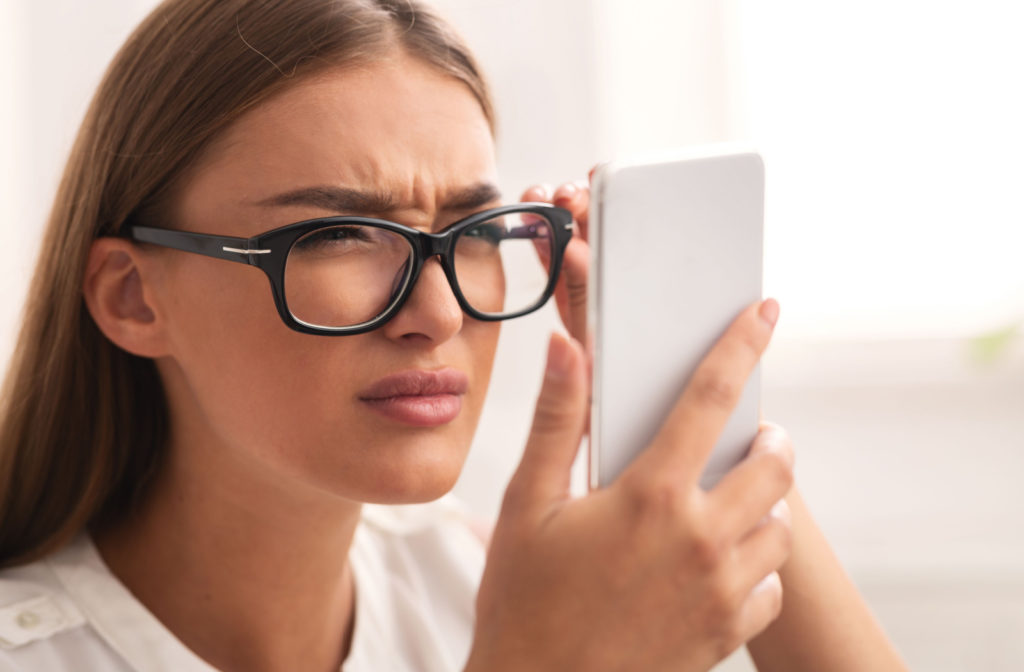Our eyes are incredible little organs, but they can develop a number of problems. Myopia, presbyopia, and hyperopia are 3 common vision issues. But what exactly do these terms mean?
These issues are refractive errors, meaning they affect how our eyes bend (refract) light.
Myopia is nearsightedness. It occurs when objects up close appear clear, but those far away are blurry.
Presbyopia is a vision error that affects everyone eventually. It’s an age-related problem that makes it difficult to see things up close.
Hyperopia is farsightedness and is essentially the opposite of myopia. It causes objects far away to appear clear, but those up close are blurry.
What Is Myopia?
Myopia, also known as nearsightedness, is a refractive error that affects how light bends inside the eye. It makes distant objects appear blurry while nearby objects remain clear. It’s caused by an eyeball that’s too long or a cornea that’s too steep, making light focus in front of the retina instead of on it.
People with myopia typically have difficulty seeing things clearly when they are further away but can see close-up objects without issue. It is often diagnosed in childhood and may worsen over time.
Myopia puts stress on the internal structure of the eye, and anyone with high myopia is at an increased risk of eye health problems like retinal detachment, glaucoma, cataracts, and macular degeneration.
Symptoms of Myopia
Common symptoms of myopia include:
- Difficulty seeing distant objects
- Squinting to improve the clarity of distant objects
- Headaches or eye strain when focusing on distant objects for long periods
- Sitting close to the TV or holding reading materials close
What Causes Myopia?
There is no single definitive cause for myopia, but rather a combination of factors, including:
- Genetics: Children whose parents have myopia are more likely to develop myopia.
- Environmental: Spending long periods indoors or doing near work like reading and using electronic devices, and not spending enough time outdoors.
- Medical conditions: Diabetes can increase the risk of myopia.
How Is Myopia Corrected?
Myopia is easily corrected with eyeglasses, contact lenses, or, for those over 18, laser eye surgery. However, because of the risks to vision, there are strategies for slowing myopia progression to help prevent eye health risks in adulthood. These strategies are called Myopia control.
Unlike correction, which adjusts the focus of light entering the eye to improve clarity of vision, control seeks to address the underlying growth of the eye that contributes to myopia.
Tools commonly used in myopia management include specialty glasses and contact lenses. At LMC Optometry, we offer MiSight contact lenses and MiYOSMART spectacle lenses as effective myopia control options:
- MiSight contact lenses: These daily contacts can slow myopia progression by up to 59%. They employ peripheral defocus to shift peripheral vision, which inhibits eye elongation.
- MiYOSMART spectacle lenses: These specialty lenses also employ peripheral defocus to shift peripheral vision and can reduce myopia progression by 60%.
Both methods are designed specifically for children and their active lifestyles.
What Is Hyperopia?
Also known as farsightedness, hyperopia is also a refractive error, but it causes nearby objects to appear blurry while distant objects appear clear. It occurs when the eye is too short or the cornea is flat, causing light to focus behind the retina instead of on it.
Symptoms of Hyperopia
People with hyperopia often experience:
- Headaches or eye strain, particularly after reading or doing close work
- Squinting or holding objects further away
- Eye strain while using digital devices for long periods
What Causes Hyperopia?
Hyperopia is usually present at birth. If you have a family history of farsightedness, there is a higher likelihood that you may also develop it.
Hyperopia may not become noticeable until later in life because the eyes compensate for farsightedness early in life. But, as the natural aging process progresses, symptoms such as difficulty reading or seeing nearby objects may become more pronounced.
Children with significant hyperopia are at a higher risk of developing amblyopia (lazy eye) or strabismus (misaligned eyes). Difficulties focusing on close objects can impact vision development.
How Is Hyperopia Corrected?
Hyperopia can be corrected with eyeglasses, contact lenses, or refractive surgery like LASIK or PRK. It can’t be prevented or cured.
What Is Presbyopia?
Presbyopia is a refractive error affecting nearly everyone as they age, usually around 40. It’s characterized by difficulty seeing up close and is often called “aging eyes.” Presbyopia develops over time due to natural age-related changes in the eye’s lens.
Why Reading Gets Harder with Age
The eye’s lens is located behind the iris and adjusts its shape to focus light so we can focus at varying distances. When looking at close objects, the lens becomes rounded and flattens when looking at distant objects.
The lens becomes less flexible as we age, making it difficult to change shape and focus on near objects. This natural change in the eye’s lens happens to everyone and can occur alongside other vision errors, like myopia and hyperopia. The muscles that control the lens also weaken with age, further impacting the ability to adjust focus.
Symptoms of Presbyopia
The most common symptom of presbyopia is the gradual loss of the ability to focus on nearby objects, like when reading or using a phone. Other symptoms may include:
- Eye strain or fatigue when doing close work
- Holding objects further away to see them clearly
- Headaches or blurred vision after extended periods of near work
How Is Presbyopia Corrected?

Presbyopia can be corrected with:
- Bifocals or reading glasses
- Progressive lenses that combine different prescriptions in one lens
- Multifocal contact lenses
- Monovision contact lenses, with one eye corrected for close vision and the other for distant vision
- Refractive lens exchange surgery, which replaces the natural lens with a multifocal or accommodating artificial lens
Experience Clear & Healthy Vision
At LMC Optometry & Eye Care, we offer comprehensive eye exams and a wide range of vision correction options to help you see clearly at all distances. Schedule an appointment with us today to find a solution for you or your child’s unique needs.



